This article contains affiliate links. We may earn a small commission if you purchase via these links.
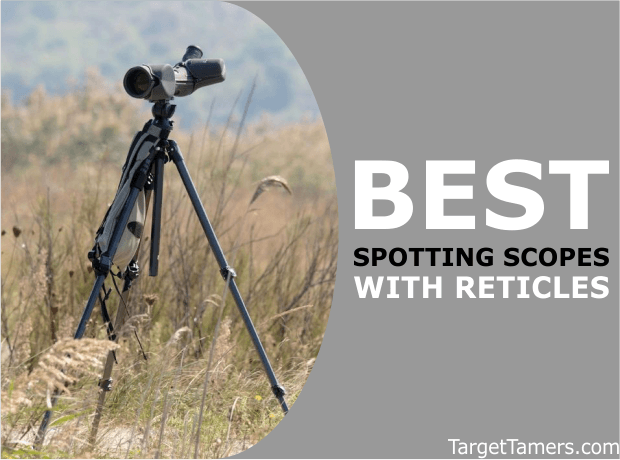
Extreme long range shooters will see the benefits of owning a spotting scope with a reticle. However, the choices are far and few between.
We've scoured out the market to compile a list of available spotting scopes with the ranging capabilities to make your next shot an accurate one.
It's game-on for the long range hunter and the bench rest shooter. Here's to a higher precision of accuracy with more extreme magnification than ever before!
QUICK LIST: 6 Best Spotting Scopes With Reticles In 2024
- Swarovski STR 80 with MOA reticle 49832
- Leupold Mark 4 with Mil-Dot Reticle 110825
- Burris Signature HD with SCR-Mil or SCR-MOA reticle
- Vortex Razor HD 27-60x85 with interchangeable reticles
- Bushnell Legend T-Series with Mil-Hash reticle
- Barska WP Tactical with Mil-Cross reticle
Best Spotting Scopes with Ranging Reticles
| IMAGE | PRODUCT | DETAILS | |
|---|---|---|---|
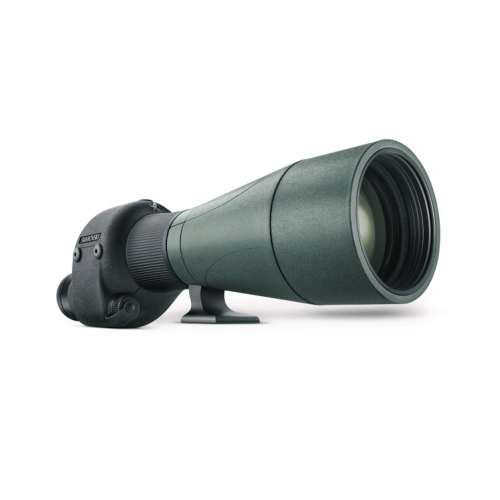 | Swarovski STR 80 with MOA reticle 49832 |
| CHECK PRICE |
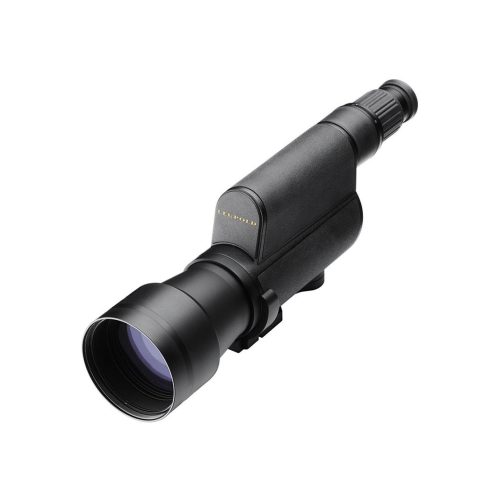 | Leupold Mark 4 with Mil-Dot Reticle |
| CHECK PRICE |
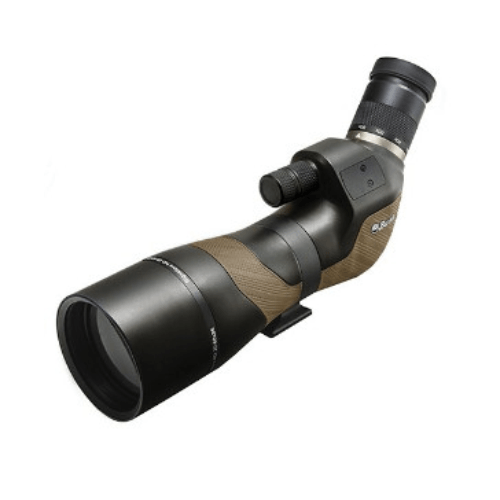 | Burris Signature HD with SCR-Mil or SCR-MOA reticle |
| CHECK PRICE |
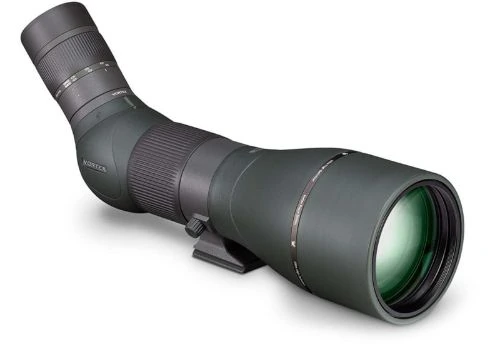 | Vortex Razor HD 27-60x85 |
| CHECK PRICE |
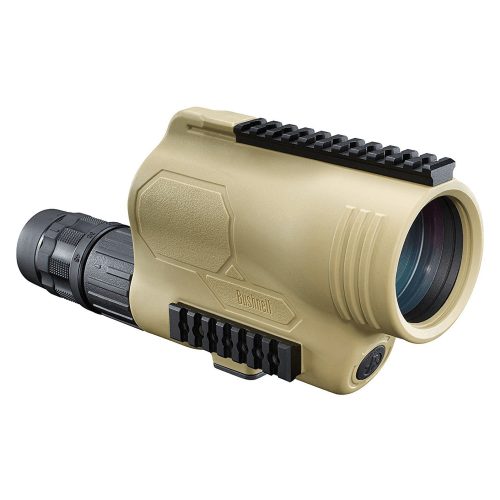 | Bushnell Legend T-Series with Mil-Hash reticle |
| CHECK PRICE |
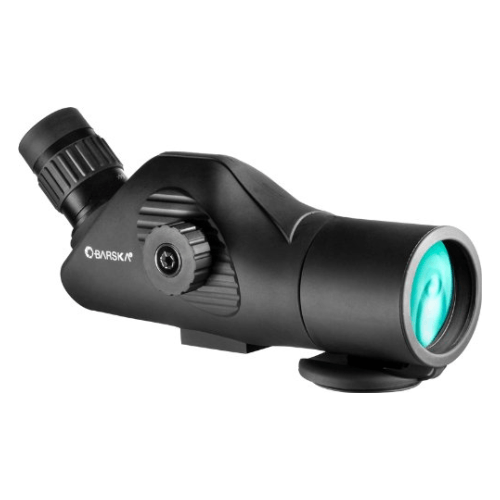 | Barska WP Tactical with Mil-Cross reticle |
| CHECK PRICE |
Why Trust Us?
After hundreds of hours of hand-testing spotting scopes in the field and at the range, and thousands more hours researching and writing about them, we feel we earn the title of experts when it comes to optics!
We purchase as many of the optics for our tests as possible, and run them through their paces to make sure they will perform at the range and in the field.
Our combined decades of experience from sstronomy and hunting, to big game hunting and competitions has been integral in putting together this round-up of the best spotting scope with reticle.
Get the inside scoop on how we test optics here.
Spotting scopes with a reticle are hardly new optics to the market, but they're definitely not as commonplace as standard spotting scopes.
But, you still might be wondering, why on earth would you need a reticle? It's a good question since you're technically not using the spotter to make your shot, you depend on your rifle scope for that. But, why couldn't you give it such a role if it could dish out the numbers you need?
With a ranging reticle, you can guesstimate size and distance of your target, and you could also get the necessary adjustments for your rifle scope all from your spotter! If you're lucky enough to have a spotter calling the shots for your long range shot, then let him do the work while you pull the trigger. Done and done.
But, there's no getting around the fact that it's the pros who are going to be interested in the ranging spotting scope. They're often very expensive, usually only available from prominent brands, and it's the long range shooters who will have the expertise to know how to integrate a spotter of this type into their shooting regimen. Needless to say, this kind of spotting scope is for serious shooters only!
Our 6 Top Ranging Spotting Scopes
1. Swarovski STR 80
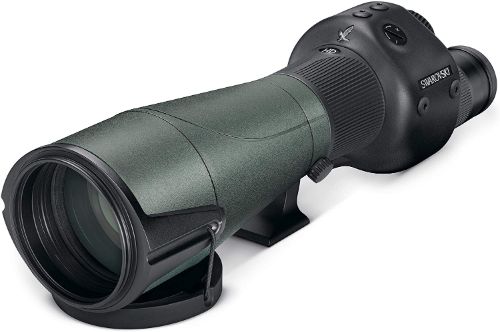
Naturally, the best of the best tops our list in the #1 spot for the ranging spotter. The Swaro STR 80 spotting scope is no ordinary beast, and you can expect that it comes with an extraordinary price tag too.
It has the interchangeable eyepiece system, so expect to pay out more cash to purchase either the 20-60X or 25-50X W eyepiece to get glassing. With either eyepiece, you have the option of having a FFP MOA or MRAD reticles to get ranging immediately and make adjustments to your rifle scope.
With variable brightness intensity settings and an on/off feature, you'll have all the benefits a spotting scope can offer available at your fingertips in any condition you find yourself in the hunt or at the range. Since it's a Swaro, there's no underestimating the glass quality. One look through this, and you'll understand why better optics cost more.
2. Leupold Mark 4 12-40x60
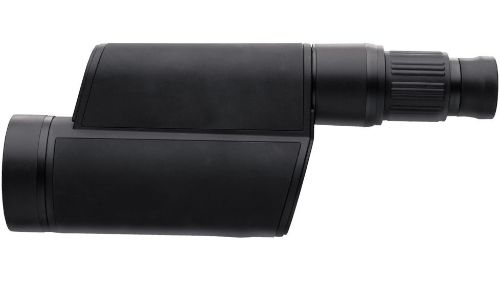
Leave it to Leupold to put a ranging reticle into a spotting scope, after all, they do know reticles better than others. With over 90 reticles available in their arsenal, they sure know how to integrate them into optics exceptionally well.
One such example is the FFP Mil Dot and TMR (Tactical Milling Reticle) available on the Mark 4 12-40x60 spotter. Although it's not illuminated, it does present an advantage on not having to have batteries and preventing failure when you need it most.
To really make this spotting scope a champion for glassing in low light conditions like dusk, it has Leupold's Xtended Twilight Lens System, Diamondcoat 2, and folded light path technology. This spotter is every bit worthy of its price tag, and if you want sure-fire accuracy, the Mark 4 can dish it!
3. Burris Signature HD 20-60X85
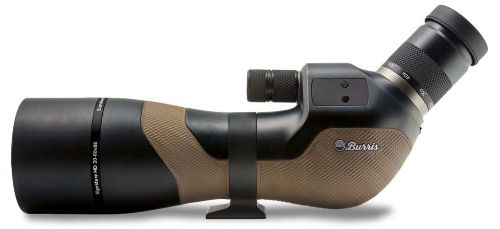
Burris has released their only spotting scope to the market, and it's brand-spanking new! The Signature HD line is the premium series for Burris' observational optics that also extends to their binoculars. So, what can you expect from the premium spotting scope?
Like many high-end spotters, this one also has the interchangeable eyepiece system. Refreshingly, the price is easier on your wallet since it comes with an included 20-60x eyepiece. However, you can also purchase a fixed 30x eyepiece with either the SCR Mil or SCR MOA reticles. If you're really not about the ranging reticle, you can get the standard 30x eyepiece, but why not go all out when you can?
With an angled design, course and fine adjustments, and the option to also purchase the compatible FastFire red dot sight, you'll be crushing it in every condition that long range hunting, competition, and even Mother Nature can throw at you!
4. Vortex Razor HD 27-60x85
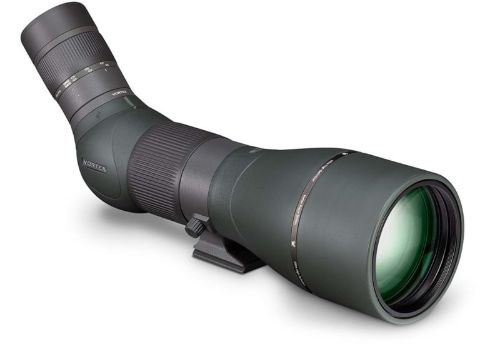
The Razor HD reticle eyepieces are needed for range work, shot corrections, and even competition use. The MOA & MRAD reticles are fixed 22x eyepieces. Only compatible with the latest generation of 85mm Razor HD spotters, they can make range work and calling shots faster and easier than ever.
Pros:
- Fixed 22x
- Wide angle
- Long eye relief
- MOA & MRAD
- Ranging reticles
Cons:
- No variable power
The interchangeable eyepieces are wide angle with a 130.3 feet FOV and 31mm of eye relief. However, fixed power does have disadvantages for some, and Vortex does not have a variable power reticle eyepiece.
The crosshairs are very thin and provide plenty of windage and elevation hashmarks for ranging distance, milling targets, and calling shots and corrections. The MOA eyepiece has .05 MOA thin crosshairs with 1 MOA distances between each mark. Hashmark lines are in two lengths with .75 and 1.5 MOA lengths. The reticle is off-centered (below) 6 MOA from the center.
The MRAD eyepiece has .02 mrad thin crosshairs with .2 mrad distances between each mark. Hashmark lines are in two lengths with .3 and .5 mrad lengths. The reticle is off-centered (below) 2 mrads from the center.
The Razor HD spotting scope comes with a 27-60x variable eyepiece. The scope has a large 85mm objective lens with a total weight of 65.6oz that is suitable for hunting, range work, and wildlife observation.
It has an APO optical system, Plasma Tech, HD Elements, and XR Plus FMC coatings. It has all the fixings of a high-end spotter with fast and fine adjustments via the helical focus, twist-up eyecups, rotating mounting knob, and Arca-Swiss compatible tripod mount. For the highest level of spotting scope performance from the Vortex brand, the Razor HD has it all.
5. Bushnell Legend Tactical T Series
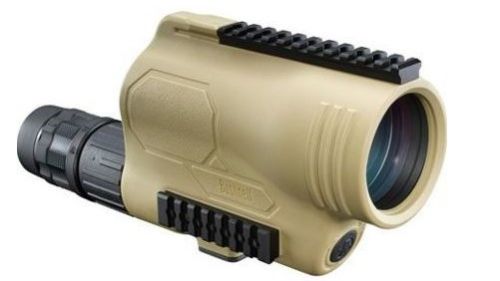
The only spotting scope in this line is the 15-45X60 spotter. While its magnification range might be on the lower end, so is its price tag. Bushnell really shows that a spotter of this caliber can be done for a low price well under $1000.
The power range is certainly ideal for the on-the-go hunter who needs a lightweight, fully weatherproof, and compact optic that isn't without the features necessary for accuracy and ranging.
Speaking of ranging, it has a mil-hash reticle that's perfectly compatible with mil-based rifle scopes. Making adjustments in the field will be faster than ever thanks to the first focal plane setting of the reticle.
However, the reticle isn't its only high-end feature. The optics have been touched-up with ED glass, RainGuard HD, PC-3 Phase Coating technology, and an ultra wide band coating. For the price, there's really no debate in which spotter is the most affordable while still being functional for the cost-conscious shooter.
6. Barska 11-33X50 WP Tactical Spotting Scope
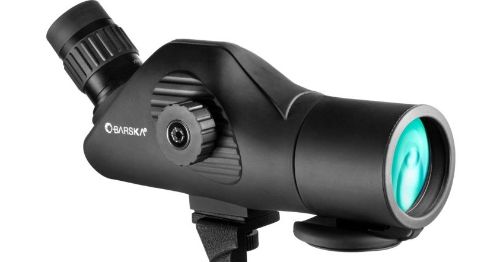
We have to include a budget-buy in this lineup simply because prices can get outrageous for a ranging spotting scope. The Barska WP Tactical is your handheld ranging spotter that you can land for under 200 bucks! It's almost unbelievable that it's priced so low, but you'll have to check out the full review to believe it.
First off, you can't beat the lightweight and compact dimensions that can mean everything to a hunter in the field. The low power is just enough to get away with handheld convenience when you don't have the time to mount up. On top of that, this tactical spotter is fully weatherproof - something you don't always see in this budget range.
The second focal plane mil-cross reticle is simple and easy to use. Did we mention it's also the cheapest ranging spotting scope on the market? With that, you know you'll have some compromises in there somewhere, but still, you might be happy to have this Barska ranging for you out to 600 yards or so in the field or at the range!
Using a Ranging Spotting Scope
Every spotting scope may be a little different, but because it includes a reticle, you're going to need to focus the spotter before any use.
Focusing a Ranging Spotting Scope
Typically, focusing a spotting scope is easy with the use of a focus wheel or knob. This will bring into focus a target at any given distance to provide sharp clarity. However, with a reticle, you'll need an additional dioptric control to focus the reticle for your eyesight.
The dioptric control or diopter will be located on the eyepiece. Various manufacturers will have differing methods on how to adjust the diopter as this is typically a one-time adjustment. You may be able to adjust it with your fingers by rotating a ring around the eyepiece similar to binoculars. Or, you may have to use a tool to change dioptric settings with a coin-style opening. You'll have to refer to the instruction manual provided with your ranging spotting scope.
The short of it is, the diopter will allow you to focus the reticle for your vision. You will then use the focus wheel or knob to focus for clarity based on your target and distance.
Using the Reticle
The reticle that you choose with your ranging spotting scope should correlate with the reticle in your rifle scope to achieve maximum effectiveness. For example, you should buy a spotting scope with an MOA reticle to match your MOA rifle scope.
The reticle is located in the eyepiece. This makes it extremely effective for users that have an interchangeable eyepiece system in their spotting scope. You can switch out eyepieces to cater to your preferences as to when you want a reticle, don't want a reticle, or if you simply want a different power range for your needs.
You'll also have to consider whether or not the reticle is in the first or second plane and which will suit your needs most. This feature will determine where the reticle sits in relation to the magnifying assembly. It also affects whether or not you can use the reticle for accurate ranging at varying magnifications. For more on subtensions and reticle use, check out our Reticle Subtension Explained article for guidance.
Benefits of a Ranging Spotting Scope
It might be a fancy trapping to many hunters to have such a feature. But, there are undeniable benefits to having a reticle available in your high-powered spotting scope. Of course, some reticles can provide more benefits with its added complexity.
- Ranging distances
- Verifying size of target
- Correlates with rifle scope adjustments
- Communication aid between rifleman and spotter
- May allow for determining target speed
What to Look For in a Ranging Spotting Scope
It's no easy task to quickly determine which spotting scope is right for you, let alone deciding on one with added features like a reticle. As always, glass and coating quality and tripod systems are vital factors to consider when considering such expensive spotters.
Other than the obvious features that you'll need to contemplate on such as design, durability, warranties, and the like, we'll give you all the other things you'll need to be aware of before you buy a ranging spotting scope!
Budget
Generally, spotting scopes with reticles are expensive. Designed for precision while working with someone at the rifle, they typically have great optical quality and excellent focusing. However, there are a couple affordable models under $1000 that could be worth considering if the budget is slim.
| Product | Price Range | Features |
|---|---|---|
| Swarovski STR 80 | Under $5000 | Swarovski glass, Interchangeable eyepieces, Submersible, MOA & MRAD reticles, Reticle On/Off |
| Leupold Mark 4 | Under $2800 | Professional-Grade Optical System, Magnesium housing, Made in USA, Mil-dot reticle, FFP reticle available |
| Burris Signature HD | Under $1500 | APO/ED glass, FFP reticles, Burris FastFire integrated attachment, Non-reticle eyepiece included |
| Vortex Razor HD | Under $1800 | APO/ED glass, Non-reticle eyepiece included, Premium-grade, VIP Warranty |
| Bushnell Legend T-Series | Under $800 | Low price, ED glass, Easy to use, Integrated Picatinny rails, Lightweight, Compact |
| Barska WP Tactical | Under $200 | Reticle eyepiece included, Compact, Lightweight, Easy to use, Tripod included, Fog/waterproof |
Reticle Type & Reticle Focus
The most efficient way to make the most of a spotting scope and riflescope is to acquire the same sighting system. This means, if your riflescope has an MOA reticle, it would be better if the spotting scopes has an MOA reticle too.
To see a sharp reticle for your vision, it must have some sort of reticle focus knob. This is usually the diopter at the eyepiece that allows you to adjust the focus of the reticle.
| Product | Reticle | Reticle Eyepiece Included |
|---|---|---|
| Swarovski STR 80 | MOA & MRAD available | No |
| Leupold Mark 4 | Mil-dot | Yes |
| Burris Signature HD | MOA & MIL available | No |
| Vortex Razor HD | MOA & MRAD available | No |
| Bushnell Legend T-Series | MIL-Hash | Yes |
| Barska WP Tactical | MIL-Cross | Yes |
Interchangeable Eyepieces
On average, premium spotting scopes will have interchangeable eyepieces but this adds a lot of cost to the overall setup. The benefit is that you can switch out eyepieces with and without reticles as you wish, that is, if they’re available.
One feature that could be extremely convenient for spotting scopes that have an integrated eyepiece with the body of the scope is an on/off reticle feature.
| Product | Magnification | Objective Lens | Interchangeable Eyepieces |
|---|---|---|---|
| Swarovski STR 80 | No | 80 mm | Yes |
| Leupold Mark 4 | 20-60x | 80 mm | No |
| Burris Signature HD | 20-60x | 85 mm | Yes |
| Vortex Razor HD | 27-60x | 85 mm | Yes |
| Bushnell Legend T-Series | 15-45x | 60 mm | No |
| Barska WP Tactical | 11-33x | 50 mm | No |
Reticle Illumination
Overall, not all reticles offer illumination, so this is feature that you must consider before you buy. The downside is that it requires a battery. Keeping spare batteries on hand is recommended but reticles may be glass-etched and visible without illumination.
| Product | Illumination | Brightness Settings | Battery Type |
|---|---|---|---|
| Swarovski STR 80 | Yes | 15 | CR123 |
| Leupold Mark 4 | No | N/A | N/A |
| Burris Signature HD | No | N/A | N/A |
| Vortex Razor HD | No | N/A | N/A |
| Bushnell Legend T-Series | No | N/A | N/A |
| Barska WP Tactical | No | N/A | N/A |
Warranties
Considering the price point of most spotting scopes with reticles, it would be recommended to examine the warranty to protect your investment. Many manufacturers now have similar and competing warranties, so the choice is yours.
| Product | Warranty |
|---|---|
| Swarovski STR 80 | 10-year warranty |
| Leupold Mark 4 | Lifetime Guarantee |
| Burris Signature HD | Forever Warranty |
| Vortex Razor HD | VIP Warranty |
| Bushnell Legend T-Series | Ironclad Warranty |
| Barska WP Tactical | 1-3 Year Warranty |
Discover precision with our top Mil Dot scopes. Ideal for long-range shooting, they offer accuracy and confidence in every shot.
Do More Than Spot, Range Away Too!
Ranging spotting scopes have their place in the market. The buying crowd may be sparse, but they're irreplaceable once you've found your niche with them.
To have the ability for higher precision of ranging and accuracy with high magnification in one optic, it's a spotter worth paying for!
Further Reading
- Maven S.3A 20-40X67 Spotting Scope Review – Hands-On Field Test!
- Maven CS.1 Review - 15-45x65 Spotting Scope (Real Hands On Field Test)
- Leupold SX2 Alpine HD Spotting Scope Review (Angled)
- Maven S.1A 25-50 X 80mm Spotting Scope Review (Angled Body)
- Zeiss Victory Harpia Spotting Scope Review - 85mm Angled with Dual Speed Focus System



